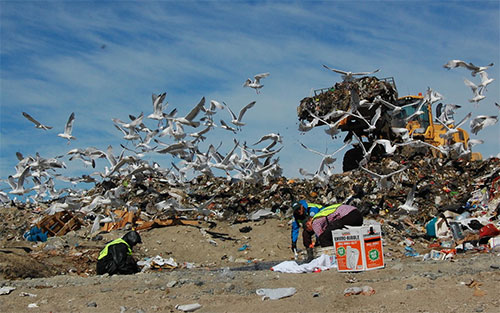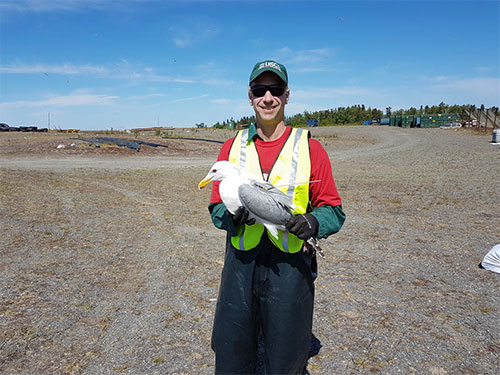
Gulls in Alaska Found to Carry Antibiotic Resistant E. coli
September 26, 2016
Gulls commonly carry E. coli and often show no signs of illness. However, this is the first report of antibiotic resistant E. coli in birds in the southcentral Alaska region. While it is still unclear how gulls are picking up antibiotic resistant strains of E. coli, possible sources include landfills and wastewater discharge.
Scientists Andrew Ramey, Bjorn Olsen, and Jonas Bonnedahl (L to R) setting a trap for gulls at the Soldotna landfill in June 2016.
“More than half of the E. coli collected from gulls on the Kenai Peninsula were resistant to at least one antibiotic compound, and a large number of multi-resistant E. coli strains were detected,” said Andy Ramey, a USGS Alaska Science Center scientist and co-author of the report. “This is higher than the number of resistant strains identified at more remote gull colonies on Middleton Island.” “Our findings suggest an increased level of antibiotic resistant bacteria in birds associated with urban environments,” said Dr. Jonas Bonnedahl, an infectious disease physician at Kalmar County Hospital in Sweden and senior author of the study. “Based on our findings, additional research may be warranted to understand the risk for re-transmission of antibiotic resistant E. coli to humans in locations where people and gulls interact.” For the past several years, ADEC, the City of Kenai, and the Kenai Watershed Forum have monitored water quality on the Kenai River. Elevated levels of bacteria have been reported in recent years, and based on other studies it was concluded that gull feces were a significant source of bacteria in the Kenai River.
John Reed (USGS scientist) holding a gull marked with a satellite transmitter at the Soldotna landfill in June 2016.
“The paper illustrates a good lesson in ecosystem health and the interrelationships of wildlife and humans,” said Alaska state veterinarian, Dr. Robert Gerlach. For questions about bacteria on the Kenai Peninsula where gulls are present, ADEC created a “Protecting Your Health While Dipnetting” brochure which can be found on the Alaska Beach Environmental Assessment and Coastal Health Program website. To reduce the chance of illness, ADEC encourages the public to use good sanitary procedures such as washing your hands after visiting a landfill or before processing fish, washing fish in clean tap water, and cooking fish to a minimum of 145 degrees internal temperature. Additionally, ADEC cautions the public to wash or shower after contact with beach water and to not drink water from the river. The new report is entitled, “Increased prevalence of antibiotic resistant E. coli in gulls sampled in southcentral Alaska is associated with urban environments” and is available at the website for the journal Infection Ecology and Epidemiology.
On the Web:
Editing by Mary Kauffman, SitNews
Source of News:
Representations of fact and opinions in comments posted are solely those of the individual posters and do not represent the opinions of Sitnews.
|
||

